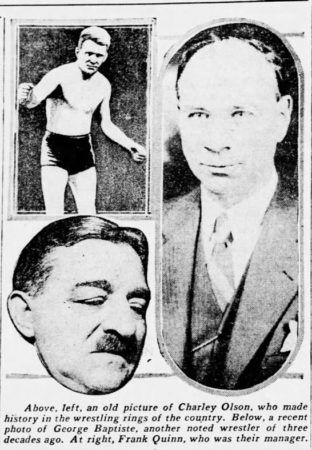Charley Olson neeg ntaus Lavxias
Hais ncaj ntsaim J. Quinn, ib lub zos me nyuam. Tus kws lij choj Louis, txais kev pab raws li tus manager saib xyuas rau kev wrestlers George Baptise, Charley Olson thiab Fred Beell. Kev admirer muas thaum chiv thawj txog George Baptiste, leej twg yog tus lus dab neeg nyob rau hauv tus me nyuam. Louis tsev ua noj thiab hom Vandeventer. Baptiste yuav ntiav Quinn raws li nws lub dab zaub thiab cov kws lij choj rau nws tsev pheebsuab thiab awning niaj hnub tom ntej.
During his travels with Baptiste, Quinn made the acquaintance of Olson and Beell. Olson, who never weighed more than 176 phaus, was matched with Baptiste in Iowa. Baptiste won the match but Olson gave him quite a struggle. Quinn and Baptiste were so impressed, they invited Olson to train with Baptiste in St. Louis. Quinn started managing Olson as well.

Photo from the 1932 St. Louis Star Times of Frank Quinn, George Baptiste and Charley Olson (Public sau)
Nyob rau hauv 1932, St. Louis Star-zaug sports columnist Walter W. Smith interviewed Quinn for one of a series of articles about early 20th Century St. Louis sports legends. Quinn, who stopped managing almost 20 years before, told an interesting story about Olson.
Some Bulgarian steel workers in Granite City thought they had a strong wrestler named Dabroff. They were willing to wager with Quinn that there man could beat any of the men in his wrestling stable. The steel workers thought Charley Olson was out of town at the time.
The match in 1907 was arranged for the Olive Street Business Men’s Gymnasium. After Quinn collected the bets, he announced Charley Olson would be facing Dabroff. Txawm li cas los, Dabroff refused to wrestle Olson. Despite the cajoling and threats of the steel workers, who would have to forfeit their wagers to Quinn, Dabroff refused to get in the ring with Olson.
The steel workers asked Quinn if the 210-pound Alex Stepanson, a Russian wrestler, could substitute for Dabroff. Quinn agreed despite Olson giving up 40 pounds to Stepanson.
Rau lub npe 7 minutes of the match, Olson struggled with the size advantage of Stepanson. Txawm li cas los, at the 7 feeb kos, Olson worked behind Stepanson and put his arm into a hammerlock. Stepanson dropped to the ground and gave up.
After a brief intercession, Olson needed less than 2 minutes to secure another hammerlock and scissors hold that ended the bout in 2 kev ncaj. The evening’s action wasn’t quite over yet.
The steel workers were furious at losing. Some workers imprudently wagered their full weekly paycheck. They charged the ring and attempted to attack Olson. George Baptiste and Quinn quickly joined the fray and with the help of the St. Louis Police successfully repelled the steel workers from the mat area. The police escorted Quinn and Olson from the gym with about $500.00 in winnings.
Quinn continued managing the men but retired from wrestling when George Baptiste retired. Txawm li cas los, he and George Baptiste would be friends and business partners for the remainder of their lives.
Koj yuav tawm ib saib los nug cov lus nug txog qhov no los yog tej tsev xa rau kuv Facebook phab.
Tau qhov twg los: St. Louis Star-zaug, Hlis ntuj nqeg 21, 1932 ib tsab, p. 18
Pin It
